Part 6 - 现在完成时被动语态
- 格式:ppt
- 大小:560.50 KB
- 文档页数:26

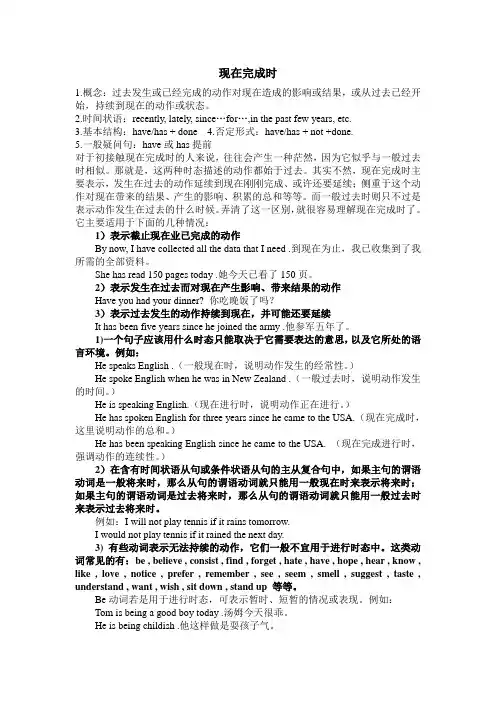
现在完成时1.概念:过去发生或已经完成的动作对现在造成的影响或结果,或从过去已经开始,持续到现在的动作或状态。
2.时间状语:recently, lately, since…for…,in the past few years, etc.3.基本结构:have/has + done4.否定形式:have/has + not +done.5.一般疑问句:have或has提前对于初接触现在完成时的人来说,往往会产生一种茫然,因为它似乎与一般过去时相似。
那就是,这两种时态描述的动作都始于过去。
其实不然,现在完成时主要表示,发生在过去的动作延续到现在刚刚完成、或许还要延续;侧重于这个动作对现在带来的结果、产生的影响、积累的总和等等。
而一般过去时则只不过是表示动作发生在过去的什么时候。
弄清了这一区别,就很容易理解现在完成时了。
它主要适用于下面的几种情况:1)表示截止现在业已完成的动作By now, I have collected all the data that I need .到现在为止,我已收集到了我所需的全部资料。
She has read 150 pages today .她今天已看了150页。
2)表示发生在过去而对现在产生影响、带来结果的动作Have you had your dinner? 你吃晚饭了吗?3)表示过去发生的动作持续到现在,并可能还要延续It has been five years since he joined the army .他参军五年了。
1)一个句子应该用什么时态只能取决于它需要表达的意思,以及它所处的语言环境。
例如:He speaks English .(一般现在时,说明动作发生的经常性。
)He spoke English when he was in New Zealand .(一般过去时,说明动作发生的时间。
)He is speaking English.(现在进行时,说明动作正在进行。
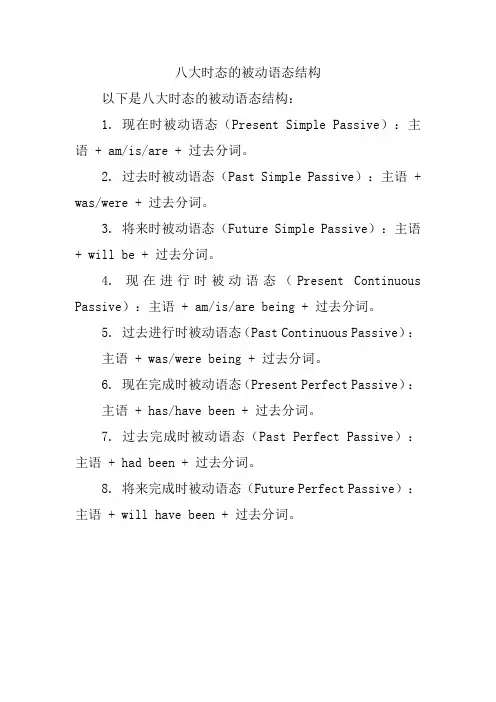
八大时态的被动语态结构
以下是八大时态的被动语态结构:
1. 现在时被动语态(Present Simple Passive):主语 + am/is/are + 过去分词。
2. 过去时被动语态(Past Simple Passive):主语 + was/were + 过去分词。
3. 将来时被动语态(Future Simple Passive):主语+ will be + 过去分词。
4. 现在进行时被动语态(Present Continuous Passive):主语 + am/is/are being + 过去分词。
5. 过去进行时被动语态(Past Continuous Passive):
主语 + was/were being + 过去分词。
6. 现在完成时被动语态(Present Perfect Passive):
主语 + has/have been + 过去分词。
7. 过去完成时被动语态(Past Perfect Passive):主语 + had been + 过去分词。
8. 将来完成时被动语态(Future Perfect Passive):主语 + will have been + 过去分词。

现在完成时的被动语态的结构和用法文章一小朋友们,今天咱们来聊聊一个有趣的语法知识——现在完成时的被动语态的结构。
你们看哦,它的结构就像是搭积木一样。
“have/has been + 过去分词”,这就是它的样子。
比如说“ The book has been read me. ” 这里“has been read”就是现在完成时的被动语态。
我们再举个例子,“Many trees have been planted in our school. ” 是不是很好理解呀?小朋友们,记住这个结构,以后就能更清楚地表达啦!文章二小朋友们,让我来给你们讲讲现在完成时的被动语态的结构哟!其实呀,它就是“have/has + been + 过去分词”。
就像“ The room has been cleaned. ” 这里“has been cleaned”就是按照这个结构来的。
再比如“ The cakes have been eaten. ” 是不是一下子就明白了呢?只要记住这个结构,我们就能说出好多这样的句子啦!文章三嘿,小朋友们!今天咱们来认识一下现在完成时的被动语态的结构。
它是这样的:“hav e/has been + 过去分词”。
比如说“ The flowers have been watered. ” 在这个句子里,“have been watered”就是这种结构。
还有像“ The dog has been washed. ” 也是一样的哦。
小朋友们,这个结构不难记吧?文章四小朋友们,我们一起来看看现在完成时的被动语态的结构吧!它的结构是“have/has been + 过去分词”。
像“ The toys have been put away. ” 这里“have been put away”就是这样的结构。
再看“ The bike has been fixed. ” 是不是很简单呀?相信聪明的你们一定能记住的!文章五小朋友们,现在来了解一下现在完成时的被动语态的结构哟!它是“have/has been + 过去分词”。
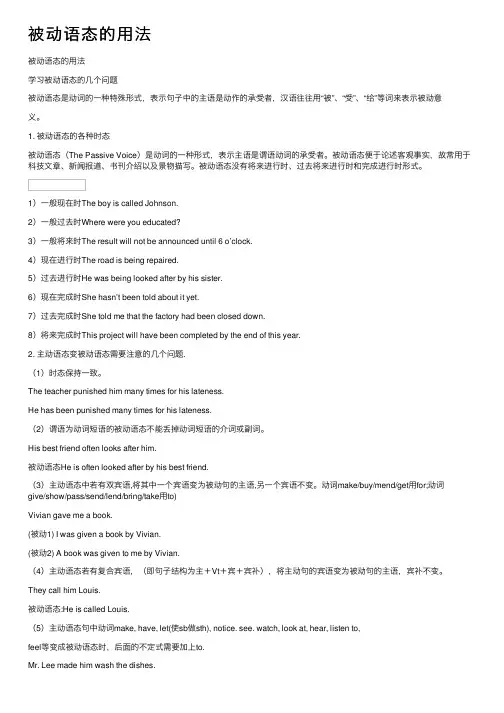
被动语态的⽤法被动语态的⽤法学习被动语态的⼏个问题被动语态是动词的⼀种特殊形式,表⽰句⼦中的主语是动作的承受者,汉语往往⽤“被”、“受”、“给”等词来表⽰被动意义。
1. 被动语态的各种时态被动语态(The Passive Voice)是动词的⼀种形式,表⽰主语是谓语动词的承受者。
被动语态便于论述客观事实,故常⽤于科技⽂章、新闻报道、书刊介绍以及景物描写。
被动语态没有将来进⾏时、过去将来进⾏时和完成进⾏时形式。
1)⼀般现在时The boy is called Johnson.2)⼀般过去时Where were you educated?3)⼀般将来时The result will not be announced until 6 o’clock.4)现在进⾏时The road is being repaired.5)过去进⾏时He was being looked after by his sister.6)现在完成时She hasn’t been told about it yet.7)过去完成时She told me that the factory had been closed down.8)将来完成时This project will have been completed by the end of this year.2. 主动语态变被动语态需要注意的⼏个问题.(1)时态保持⼀致。
The teacher punished him many times for his lateness.He has been punished many times for his lateness.(2)谓语为动词短语的被动语态不能丢掉动词短语的介词或副词。
His best friend often looks after him.被动语态He is often looked after by his best friend.(3)主动语态中若有双宾语,将其中⼀个宾语变为被动句的主语,另⼀个宾语不变。
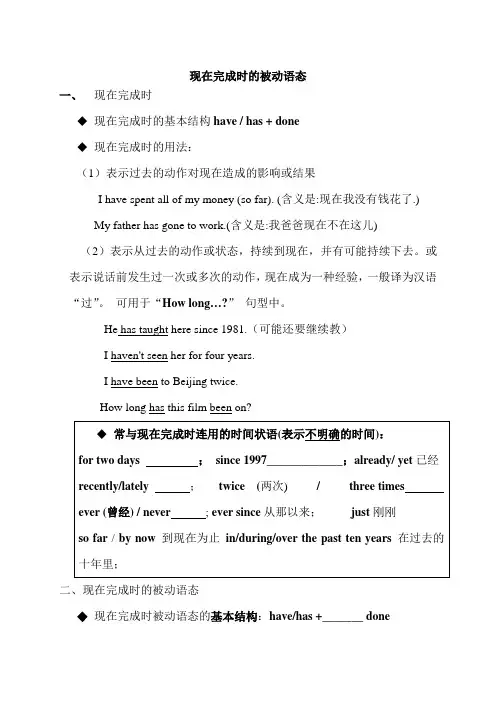
现在完成时的被动语态一、现在完成时◆现在完成时的基本结构have / has + done◆现在完成时的用法:(1)表示过去的动作对现在造成的影响或结果I have spent all of my money (so far).(含义是:现在我没有钱花了.)My father has gone to work.(含义是:我爸爸现在不在这儿) (2)表示从过去的动作或状态,持续到现在,并有可能持续下去。
或表示说话前发生过一次或多次的动作,现在成为一种经验,一般译为汉语“过”。
可用于“How long…?”句型中。
He has taught here since 1981.(可能还要继续教)I haven't seen her for four years.I have been to Beijing twice.How long has this film been on?二、现在完成时的被动语态◆现在完成时被动语态的基本结构:have/has +_______ done现在完成时被动语态的否定结构:complete______________ admit_______________ raise______________ replace______________ advertise_____________ solve_____________1. She has cleaned the windows.(改成被动语态)主语谓语宾语The windows (by her).主语谓语2. He hasn’t washed the dirty clothes. (改成被动语态)____________________________________________将下列句子改成被动语态。
1. Mary has locked the door.2. I have finished my homework.3. I have read this book many times.4. Tom has not repaired the computer.5. Jane has referred to the book.6. We have put up a notice on the wall.三、注意事项:1.与一般过去时的被动语态的区别。
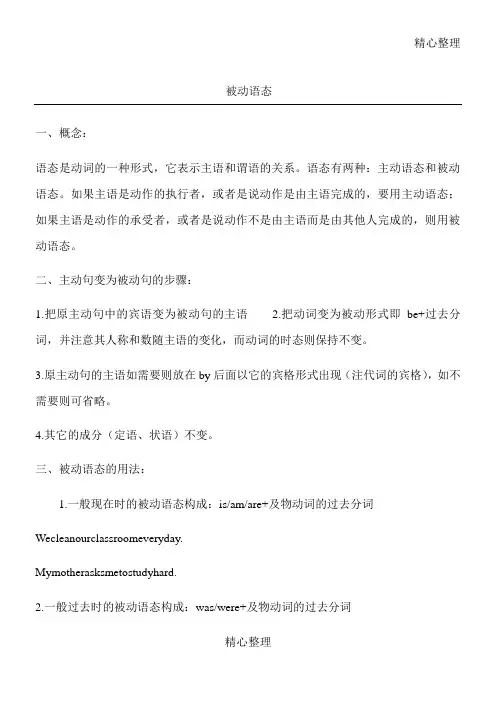
精心整理被动语态一、概念:语态是动词的一种形式,它表示主语和谓语的关系。
语态有两种:主动语态和被动1.3.,如不4.Wecleanourclassroomeveryday.Mymotherasksmetostudyhard.2.一般过去时的被动语态构成:was/were+及物动词的过去分词Anewshopwasbuiltlastyear.3.现在完成时的被动语态构成:has/have+been+及物动词的过去分词Thisbookhasbeentranslatedintomanylanguages.Manyman-madesatelliteshavebeensentupintospacebymanycountries.4.5.6.7.Therearetwobookstoberead. Therearetwentymoretreestobeplanted.3.感官动词或使役动词使用省略to的动词不定式,主动语态中不带to,但变为被动语态时,须加上to。
例:makesomebodydosomething→somebody+be+madetodosomething seesomebodydosomething→somebody+be+seentodosomething Agirlsawmywalletdropwhenshepassedby.→Mywalletwasseentodropbyagirlwhenshepassed by.ss.4.→Anewbikewasboughtfo rmebymyfather.5.一些动词短语用于被动语态时,动词短语应当看作一个整体,而不能丢掉其中的介词或副词。
Wecan’tlaughathim.→Hecan’tbelaughedatbyus.Helistenstotheradioeveryday.→Theradioislistenedtobyhimeveryday. Thenurseistakingcareofthesickman.→Thesickmanisbeingtakencareofbythenurse.不用被动语态的情况1)不及物动词或动词短语无被动语态(即多数的瞬间动词):束(错(对(错(对(错(对)Thepricehasbeenraised.(错)Pleaseseat.(对)Pleasebeseated.要想正确地使用被动语态,就须注意哪些动词是及物的,哪些是不及物的。
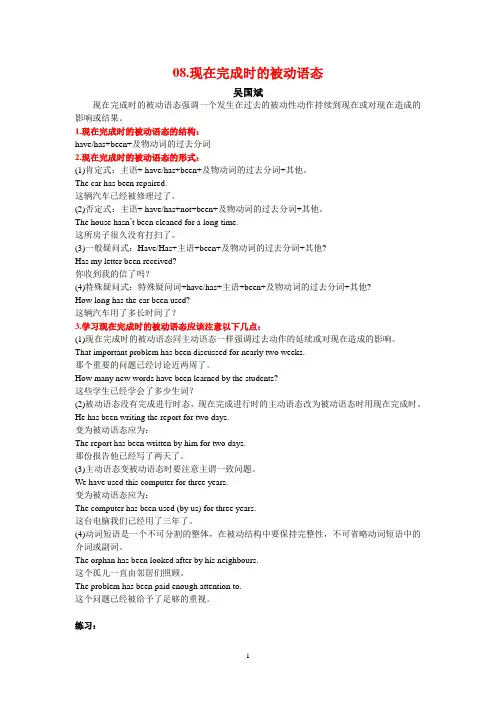
08.现在完成时的被动语态吴国斌现在完成时的被动语态强调一个发生在过去的被动性动作持续到现在或对现在造成的影响或结果。
1.现在完成时的被动语态的结构:have/has+been+及物动词的过去分词2.现在完成时的被动语态的形式:(1)肯定式:主语+ have/has+been+及物动词的过去分词+其他。
The car has been repaired.这辆汽车已经被修理过了。
(2)否定式:主语+ have/has+not+been+及物动词的过去分词+其他。
The house hasn’t been cleaned for a long time.这所房子很久没有打扫了。
(3)一般疑问式:Have/Has+主语+been+及物动词的过去分词+其他?Has my letter been received?你收到我的信了吗?(4)特殊疑问式:特殊疑问词+have/has+主语+been+及物动词的过去分词+其他?How long has the car been used?这辆汽车用了多长时间了?3.学习现在完成时的被动语态应该注意以下几点:(1)现在完成时的被动语态同主动语态一样强调过去动作的延续或对现在造成的影响。
That important problem has been discussed for nearly two weeks.那个重要的问题已经讨论近两周了。
How many new words have been learned by the students?这些学生已经学会了多少生词?(2)被动语态没有完成进行时态,现在完成进行时的主动语态改为被动语态时用现在完成时。
He has been writing the report for two days.变为被动语态应为:The report has been written by him for two days.那份报告他已经写了两天了。

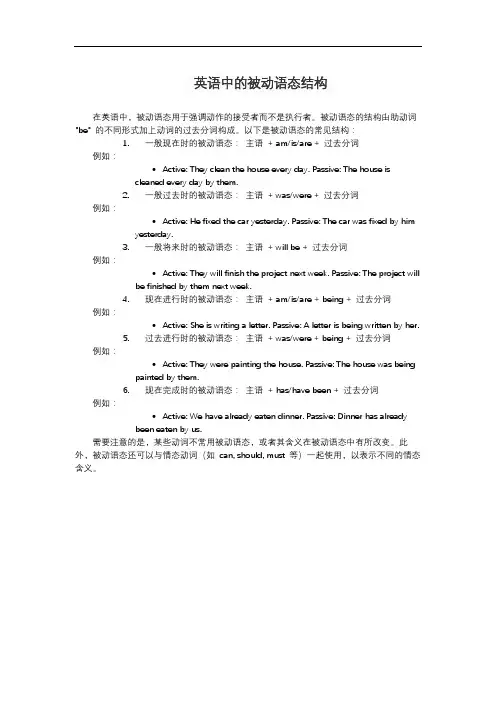
英语中的被动语态结构在英语中,被动语态用于强调动作的接受者而不是执行者。
被动语态的结构由助动词"be" 的不同形式加上动词的过去分词构成。
以下是被动语态的常见结构:1.一般现在时的被动语态:主语+ am/is/are + 过去分词例如:•Active: They clean the house every day. Passive: The house iscleaned every day by them.2.一般过去时的被动语态:主语+ was/were + 过去分词例如:•Active: He fixed the car yesterday. Passive: The car was fixed by him yesterday.3.一般将来时的被动语态:主语+ will be + 过去分词例如:•Active: They will finish the project next week. Passive: The project will be finished by them next week.4.现在进行时的被动语态:主语+ am/is/are + being + 过去分词例如:•Active: She is writing a letter. Passive: A letter is being written by her.5.过去进行时的被动语态:主语+ was/were + being + 过去分词例如:•Active: They were painting the house. Passive: The house was being painted by them.6.现在完成时的被动语态:主语+ has/have been + 过去分词例如:•Active: We have already eaten dinner. Passive: Dinner has already been eaten by us.需要注意的是,某些动词不常用被动语态,或者其含义在被动语态中有所改变。
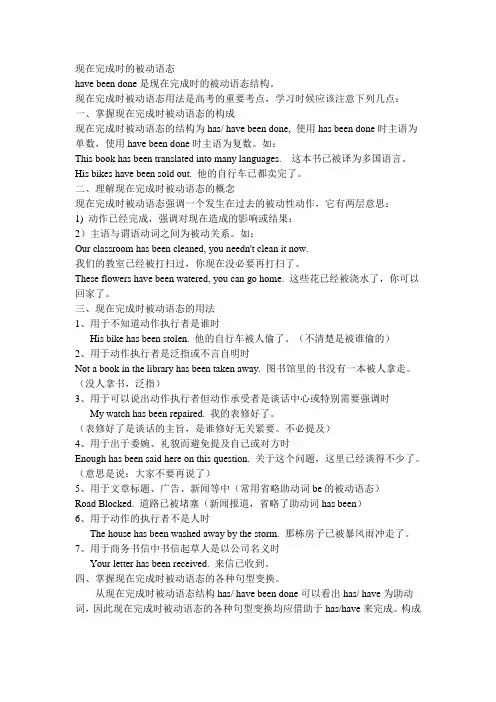
现在完成时的被动语态have been done是现在完成时的被动语态结构。
现在完成时被动语态用法是高考的重要考点,学习时候应该注意下列几点:一、掌握现在完成时被动语态的构成现在完成时被动语态的结构为has/ have been done, 使用has been done时主语为单数,使用have been done时主语为复数。
如:This book has been translated into many languages.这本书已被译为多国语言。
His bikes have been sold out. 他的自行车已都卖完了。
二、理解现在完成时被动语态的概念现在完成时被动语态强调一个发生在过去的被动性动作,它有两层意思:1) 动作已经完成,强调对现在造成的影响或结果:2)主语与谓语动词之间为被动关系。
如:Our classroom has been cleaned, you needn't clean it now.我们的教室已经被打扫过,你现在没必要再打扫了。
These flowers have been watered, you can go home. 这些花已经被浇水了,你可以回家了。
三、现在完成时被动语态的用法1、用于不知道动作执行者是谁时His bike has been stolen. 他的自行车被人偷了。
(不清楚是被谁偷的)2、用于动作执行者是泛指或不言自明时Not a book in the library has been taken away. 图书馆里的书没有一本被人拿走。
(没人拿书,泛指)3、用于可以说出动作执行者但动作承受者是谈话中心或特别需要强调时My watch has been repaired. 我的表修好了。
(表修好了是谈话的主旨,是谁修好无关紧要。
不必提及)4、用于出于委婉、礼貌而避免提及自己或对方时Enough has been said here on this question. 关于这个问题,这里已经谈得不少了。
各种时态的被动语态一、八大时态的被动语态的构成:1.一般现在时的被动语态构成:(am/is/are +done)如:I am asked to study hard. 我被请求努力学习。
This shirt is washed once a week. 这件T恤一周洗一次。
These songs are usually sung by boys. 这些歌曲通常是男生唱的。
2.一般过去时的被动语态构成:(was/were done)如:The soldier was killed, but the train was saved. 这位战士牺牲了,然而列车得救了。
Some notes were passed up to the speaker. 有人给讲演者递上来一些纸条。
3.一般将来时的被动语态构成:(shall/will be done)如:We shall be asked a lot of strange questions. 我们将被问许多怪题。
My son will be sent to school next September. 来年九月我将送我儿子去读书。
4.过去将来时的被动语态构成:(should/would be done)如:The news would be sent to him as soon as it arrived. 消息一到就会转给他的。
He told us that the new railway would be built the next year. 他告诉我新铁路将在明年修建。
5.现在完成时的被动语态构成:(has/have been done)如:The work has just been finished. 工作刚刚结束。
The old rules have been done away with by us. 旧规章已经被我们废除了。
6.过去完成时的被动语态构成:(had been done)如:By last December three ships had been built by them. 到去年十二月底他们已建造了三艘船。
初中被动语态全解语态表示主语和谓语的关系,英语的语态是通过动词形式的变化表现出来的。
英语中有两种语态:主动语态和被动语态。
如果主语是动作的执行者,或者是说动作是由主语完成的,要用主动语态,如:We speak Chinese in China.在中国我们说汉语,speak的动作是由主语we来执行的。
如果主语是动作的承受者,或者是说动作不是由主语而是由其他人完成的,则用被动语态,如:Chinese is spoken by us in China.在中国汉语被我们说,Chinese是动词speak的承受者。
一.被动语态的时态:be +动词的过去分词1.一般现在时的被动语态结构:is /am/are +及物动词的过去分词+其它+by sb.Football (play)all over the world。
Many trees (plant)in North China.Rice (grow)in South China.A camera (use)for taking photosI often (ask)to do this work.2.一般过去时的被动语态结构:was /were+及物动词的过去分词+其它+by sb.The house (build)in 1978.All the students _____________ (ask) to bring a kite with them last SundayThe car (clean) by Dad yesterday.I (tell)to wait for him right here.When the present (give)to him by his mother?3含有情态动词的被动语态结构:情态动词can / may / must / should + be + 及物动词的过去分词+其它+by sb.Chocolate may (send) to him as a present.Computers should (look)after well.Can this kind of machine (mend)by Uncle Wang?No stars can (see)in the day-time by us.Must the old people ____________ (speak) to politely?主动语态变为被动的几个特殊情况①有些动词在主动结构中,后面接不带to的不定式,但如果改为被动,则需把省略的to加上,这类动词有[let, make, have,help]和感官动词[feel,see,hear,watch,look at,listen to],如:The boss made my grandfather work 10hours a day.改成My grandfather was made to work for 10 hours a day.②含有宾语从句的主动结构变为被动,通常用it作为被动结构的先行主语,从句放在句子后面/也可采用另一种形式,这类动词有:know, say, believe, find, think, report等③是所有的主动句都可以变换成被动句,更不是所有的被动句都可以自由变换成主动句。
现在完成时的主动与被动的句子
现在完成时是英语中的一种时态,用于表示过去发生的动作或事件对现在造成的影响或状态。
它可以用于主动语态和被动语态。
下面我将为你提供主动和被动语态的现在完成时句子示例:
**主动语态(Active Voice):**
1. I have finished my homework.(我已经完成作业。
)
2. She has written three books.(她已经写了三本书。
)
3. They have eaten dinner.(他们已经吃过晚饭。
)
**被动语态(Passive Voice):**
1. My homework has been finished.(我的作业已经被完成。
)
2. Three books have been written by her.(三本书已经被她写过。
)
3. Dinner has been eaten by them.(晚饭已经被他们吃过。
)
请注意,被动语态中的句子结构是由助动词"have been"(根据主语的人称和数变化)和过去分词构成的。
在被动语态中,动作的执行者变成了句子的主语之外的部分,而受动作影响的对象成为了主语。
英语(十八)Book2 Unit 3 语法现在完成时的被动语态构成:have/has been done 第三人称单数用has,第三人称复数以及其余人称用have。
否定式是在have/has 后加not,也可缩写成haven’t/hasn’t;构成疑问句时,附加问句借助于have/has。
特殊疑问句式:疑问词+have/has+主语+been+及物动词的过去分词。
1.表示发生在过去的动作对现在产生的影响或结果,这个动作是被动的。
This novel has been translated into several languages.2.还可以表示在过去发生的,已知延续到现在的并可能持续延续下去的被动动作或状态。
常与for或since引导的时间状语连用,或用于“How long…?”句型中。
The machine has been used for 3 years.3.用在时间或条件状语从句中,表示将来某时已完成的动作,即用现在完成时态的被动语态代替将来完成时的被动语态。
You can go home as soon as your homework has been finished.4.注意1)现在完成时的被动语态的两个助动词:have/has和been 缺一不可。
2)注意与一般过去时被动语态的区别。
一般过去时的被动语态表示一个被动的动作发生在过去,其结果对现在没有影响;而现在完成时的被动语态的动作或状态尽管发生在过去,但侧重说明该动作或状态对想在造成的影响或结果。
The machine has been repaired.(说明动作发生在过去,对现在有影响,“修好了”) The machine was repaired yesterday.(只说明动作发生在昨天)3)不可与确定的表过去或将来的时间状语连用(如yesterday,three days ago,in 1970,in 2050等),但可与不确定的时间状语连用(如already,yet,just,often,recently,in the past few years等)They have been punished recently.4)有些动词像finish,buy,start,begin,return,join,marry,open,die等,表示的动作很短暂,我们称之为短暂性动词或非延续性动词。
解析各种时态的被动语态的构成英语中有两种语态:主动语态和被动语态。
语态是动词的一种形式,用来说明主语和谓语之间的关系。
语态的作用:语态是动词的一种形式,用来说明主语和谓语之间的关系。
语态的选用:如果主语是动作的执行者,谓语用主动语态。
例如:We clean the room every day.如果主语是动作的承受者,或者说是动作的对象,谓语则是要用被动语态。
例如:The room is cleaned every day.如果主语是动作的执行者,谓语用主动语态,如“We c lean the room every day.”;如果主语是动作的承受者,或者说是动作的对象,谓语则是要用被动语态,如“The room is cleaned every day.”★被动语态的各种形式:说明:1、一般现在时:am/is/are+过去分词:I’m asked to take care of myself.Football is played all over the world.2、一般过去时:was/were+过去分词:This house was built in 1958.His leg was broken in an accident.3、一般将来时:will/shall be+过去分词:More factories will be built in our city.He will be taken to hospital tomorrow.4、现在进行时:am/is/are being+过去分词:A road is being built around the mountain.Many new houses are being built in this city.5、过去进行时:was/were being+过去分词:The meeting was being held when I was there.We were being trained this time last year.6、现在完成时:have/has been+过去分词:This book has been translated into many foreign languages.The prices of many goods have been cut again .7、过去完成时:had been + 过去分词:A new school had been set up by the end of last year.When the anthem had been played the conference began.8、将来完成时:shall/will have + 过去分词:The project will have been completed before July.Your clothes shall have been made for you soon.9、过去将来完成时:should/would have + 过去分词:He told me that his new cloths would be made by his mother.He told me that his new clothes would have been made very soon.★英语被动语态常见考点:动词的语态一般不单独考,而是和时态、语气和非谓语动词一起考,需要注意以下考点。